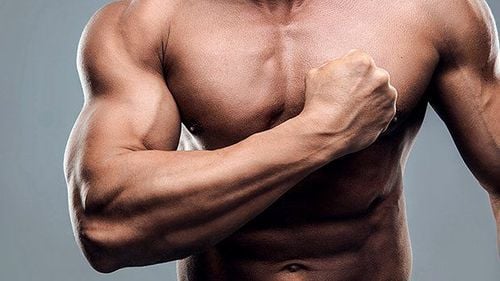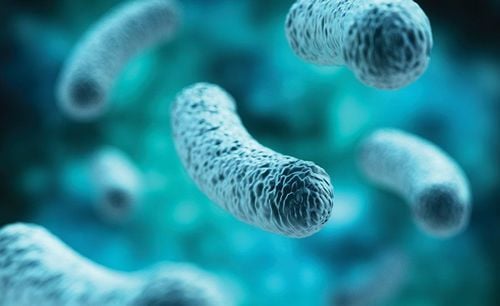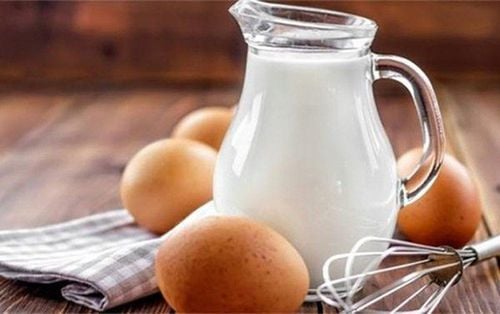This is an automatically translated article.
A lot of people want to have a healthy body with lots of muscles. However, the training and nutrition to be able to increase muscle mass always requires many factors and not everyone can do it well. So, how to gain muscle effectively1. How to increase muscle mass?
Building muscle is why most of us keep coming back to the gym. It's that spark that continues to fuel our strenuous workouts that many consider us crazy, but how do we effectively build muscle? That is a question that many practitioners ask.Physical activity to build muscle is easier said than done because in order to build muscle we need many elements that match both our training regimen and our nutrition.
A great starting point for everyone looking to add mass to their muscle is to first define what the actual muscle building process is. The activity of building muscle, or the desire to make muscle grow through resistance training, is commonly known as muscle hypertrophy.
Muscle hypertrophy is the adaptation that our muscles undergo from constant exposure to progressive forms of resistance training, resulting in an increase in muscle fiber size, both in diameter and length. . Basically, muscle hypertrophy is the process by which our muscles become physically larger through consistent and harder training.
Remember, effort is one of the surest drivers of muscle gain over time.
If you note the definition above, the progressive muscle resistance mentioned above is necessary to add your muscle mass. Continuously increasing resistance leads to the creation of some form of strategic effort, increasing based on the style of training you are performing.

Cần có nhiều yếu tố cả về dinh dưỡng và luyện tập để có thể xây dựng cơ bắp hiệu quả
Note, your muscle building strategy need not be so rigid that there is no room for fun. In fact, you can still eat the meals you like and you don't need to spend hours in the gym, as long as you're working out and strategically fueling yourself most of the time. . The goal is to create a muscle-building plan that fits your goals and needs.
The tips below will help you—whether you're a beginner or someone reaching an uncomfortable training stage—build muscle with a strategic and practical means.
2. Methods to increase muscle mass
2.1. Maximize Muscle Building The more protein your body stores — in a process called protein synthesis — the more your muscles will grow. But your body is constantly expending its protein reserves for other uses — like making hormones, for example.As a result, there is less protein to build muscle. To combat that, you need to "build and store new proteins faster than the body breaks down old proteins," says Dr. Michael Houston, professor of nutrition at Virginia Tech University.
According to a landmark study in the Journal of Applied Physiology, consume about 1 gram of protein per pound of body weight, which is roughly the maximum amount your body can use in a day.
For example, a 160-pound man should consume 160 grams of protein a day — the amount he gets from an 8-ounce chicken breast, 1 cup of cheese, a roast beef sandwich, two eggs, a glass milk, and 2 ounces of peanuts. Divide the remaining daily calories evenly between carbohydrates and fats.

Cơ thể bạn dự trữ càng nhiều protein thì cơ bắp của bạn càng phát triển
2.3. Work harder Yes, biceps curls are fun, but if you want to build muscle, you have to challenge your body more. And one key to doing that is working through so-called "multi-joint" movements. Working a muscle group is valuable, but it shouldn't be the backbone of your training.
Instead, you want to do exercises that challenge multiple joints and muscles at once. for example, weightlifting. Each time represents a challenge row for biceps, abs and abs. Using multiple muscle groups allows you to lift more weight, which is a major growth promoter (more on that later). And it motivates you to use the muscles together, just like you would in real life. Multi-joint movements are key in your workout.
Make sure moves like squats, deadlifts, pullups and bench press are included in your workout to take advantage of it. All will stimulate many muscle groups at the same time, if you want to develop, you must do so.
2.4. Train more If you want to build muscle and strength, you have to train hard. Hard, safe and effective exercise offers many benefits. Heavy workouts not only challenge the concentric muscles but also the eccentrics. If not correct, the stimulus of the heavy weight controlled downwards and backwards will cause more muscle to tear and rebuild.

Luyện tập nặng là một trong những cách hữu hiệu để xây dựng cơ bắp
One way you can approach this in your training: End every workout with an exercise that allows you to work out at a low pace. Do 4 sets of 3-5 reps on your first exercise, then do 3 sets of 10-12 reps for each move after that. "It's the best of both worlds," says Samuel, "allowing you to build pure power early, then accumulate rep later."
2.5. Drink water before a workout A 2001 study at the University of Texas found that exercisers who drank a shake containing amino acids and carbohydrates before exercise increased their protein synthesis more than lifters. people who drink the same shake after exercise.
The shake contains 6 grams of essential amino acids - the building blocks of muscle-building protein - and 35 grams of carbohydrates. “Since exercise increases blood flow to your active tissues, drink a carbohydrate-protein blend first,” says Kevin Tipton, Ph.D., a nutrition and exercise researcher at the University. exercise can lead to more absorption of amino acids in your muscles.
For your shake, you'll need about 10 to 20 grams of protein — usually about a scoop of whey-protein powder. Does the drink have protein for the stomach? You can get the same nutrients from a 4-ounce turkey sandwich and a slice of American cheese on whole-wheat bread. But a drink is better.

Uống nước trước khi tập luyện là một cách làm tăng cơ bắp
This doesn't mean you can't exercise too often. However, limit the exercises that bring your body to the breaking point to three times a week, never on days in between. You need recovery to grow. Constantly training to the point of exhaustion is counterproductive to the recovery needed to build muscle.
2.7. Reduce Carbs After Your Workout Research shows that you'll rebuild muscle faster on rest days if you feed your body with carbohydrates.
Post-workout meals with carbs will increase your insulin levels, which in turn slows down the rate at which protein is broken down. Eat a banana, a sports drink, a peanut butter sandwich.
2.8. Eat something every 3 hours If you don't eat often enough, you can limit the rate at which your body makes new proteins.
Take the number of calories you need in a day and divide by six. That's the amount you should eat at each meal. Make sure you consume a good amount of protein — about 20 grams — every 3 hours.
2.9. Eat Ice Cream After Workout This tip will be the easiest to follow by far: Eat a bowl of ice cream (any type) 2 hours after your workout.
According to a study in the American Journal of Clinical Nutrition, this snack stimulates an insulin spike better than most foods. And that will reduce protein breakdown after a workout.
2.10. Drink milk before bed Eat a combination of carbohydrates and protein 30 minutes before bedtime. According to Kalman, calories are more likely to stick to you during sleep and reduce protein breakdown in muscles.
Try a cup of raisin bran with a cup of skim milk or a small cup of cheese and a small bowl of fruit. Eat again as soon as you wake up.
Please dial HOTLINE for more information or register for an appointment HERE. Download MyVinmec app to make appointments faster and to manage your bookings easily.
References: menshealth.com, verywellfit.com, health.harvard.edu












